Cite this document
(“American Revolution in 1775-1783 Term Paper Example | Topics and Well Written Essays - 1500 words”, n.d.)
Retrieved from https://studentshare.org/history/1454176-segment
Retrieved from https://studentshare.org/history/1454176-segment
(American Revolution in 1775-1783 Term Paper Example | Topics and Well Written Essays - 1500 Words)
https://studentshare.org/history/1454176-segment.
https://studentshare.org/history/1454176-segment.
“American Revolution in 1775-1783 Term Paper Example | Topics and Well Written Essays - 1500 Words”, n.d. https://studentshare.org/history/1454176-segment.


